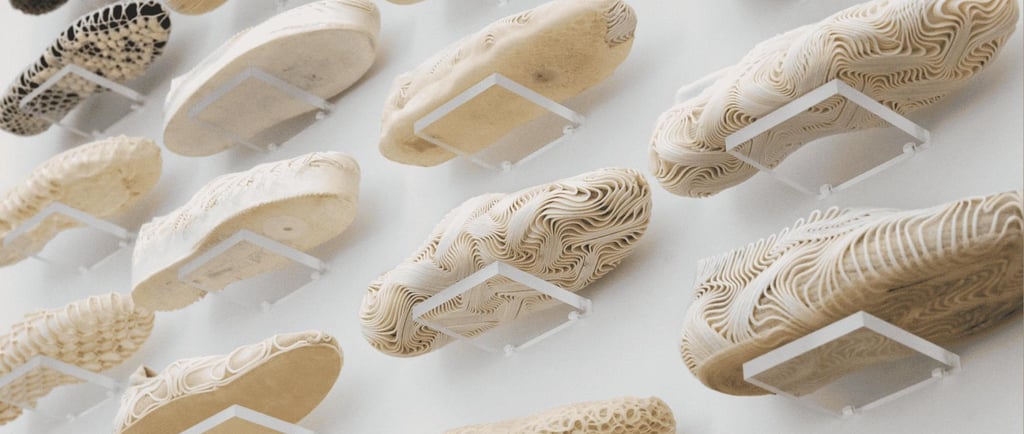Step Forward” – The Fully Biodegradable Shoe That Leaves No Footprint
What if your sneakers didn’t just wear out, what if when you were done with them, they turned into compost, returned harmlessly to the earth, and left almost nothing behind?
Kylo B
10/13/20253 min read


Step Forward” – The Fully Biodegradable Shoe That Leaves No Footprint
What if your sneakers didn’t just wear out, what if when you were done with them, they turned into compost, returned harmlessly to the earth, and left almost nothing behind? This is the ambitious idea behind the O° shoe, a project of the Oxman design lab. It aims to reimagine footwear so it has no lingering environmental cost when its life is over. Positive News+1
What is the O° Shoe?
The O° shoe is a concept (moving toward production) for footwear that is fully biodegradable. Here are its major features: Positive News
Material base: It is made entirely from polyhydroxyalkanoates (PHAs), which are plastics produced by certain bacteria. These bacteria feed on carbon dioxide, methane, or organic waste, making the PHAs much more sustainable than conventional petroleum-based plastics. Positive News
Construction: The design uses a knitted PHA-yarn base, onto which outer layers of PHA are applied via 3D printing. The process avoids petrochemicals and glues, meaning fewer harmful or non-decomposing additives. Positive News
Pigments & dyes: Only bacteria-derived pigments are used for coloring, further keeping the materials in the biological/organic domain. Positive News
In short, every component, base, outer shell, color and finish — is designed to break down naturally, without leaving toxic residue. Oxman describes its goal as “minimize harm in its conception and nourish the environment in its afterlife.” Positive News
Why This Matters
The footwear industry has a big environmental problem:
Shoes usually combine dozens of materials, plastics, synthetic rubbers, glues, metal eyelets, etc. These often cannot be recycled or composted, and many end up in landfills, taking decades to degrade (or never fully doing so). Positive News
Microplastics from wear and tear, washing, etc., contribute to soil and marine pollution.
A fully biodegradable shoe promises to reduce or eliminate many of these issues: less long-term waste, less plastic pollution, and a smaller ecological footprint over the life cycle. In theory, a shoe like O° could represent a major step toward more sustainable fashion/footwear, especially as awareness of the environmental costs of fast fashion grows.
What’s Still Not Fully Known or Challenges Ahead
While the idea is very promising, there are several important questions and hurdles to address before something like this can become widely adopted and make a big impact:
Durability vs Biodegradability
It’s easy to make something biodegradable but hard to make it durable enough for everyday use. Shoes need to handle sweat, abrasion, flexing, moisture, weather, etc. If the material degrades too quickly (or prematurely), the shoe won’t last long enough to justify its cost or environmental benefit.Scale of production and cost
Producing PHAs, knitting the base, 3D printing outer shells, using bacteria-derived pigments, these are more complex and (likely) more expensive processes than mass manufacturing with synthetics. Costs, production capacity, supply chains, and reliability all matter.End-of-life logistics
Even if a shoe is fully biodegradable, whether it actually biodegrades depends on how it’s disposed of. Industrial composting or special biodegradation conditions may be required. If a biodegradable shoe ends up in a landfill with no oxygen, or gets mixed with non-biodegradable waste, the benefits can be lost.Certifications, safety, and performance
For consumers to trust the claims (“fully biodegradable,” “no glues,” “non-toxic dyes”), independent testing, certifications, and standards will be key. Performance matters: comfort, fit, support, breathability, etc., must be comparable to non-biodegradable shoes or people won’t adopt them widely.Environmental trade-offs
Sometimes new materials or processes might reduce one kind of impact (waste, plastic) but increase others (water use, energy, transport emissions). A full life-cycle analysis is necessary to ensure that in replacing plastics with PHAs, for example, the net impact is indeed lower.
The Path Forward & Potential
What makes the O° shoe stand out is that it pushes the boundary by trying to eliminate petrochemicals, glues, and synthetic additives, not just reducing or replacing parts of the shoe. If it can be made realistically durable, cost-effective, and produced at scale, it could influence not only design of shoes but also broader trends in sustainable materials.
Potential opportunities include:
Partnerships with footwear brands to co-develop or license the technology.
Using biodegradable shoes in contexts where disposal is problematic (e.g. regions with weak waste management, or events/festivals where many shoes are discarded).
Inspiring policy or regulation around end-of-life standards for footwear (e.g. requiring biodegradability, compostability, or better labelling).
Conclusion
The O° shoe from Oxman is an exciting development in sustainable fashion. It suggests a future where footwear doesn’t become an environmental burden once it’s worn out. However, the journey from concept to mass-market will require overcoming technical, economic, and logistical challenges.
If it succeeds, it won’t just leave no footprint, it might redefine what we expect from all products: that their lifecycle, from origin to disposal, truly respects the environment.

